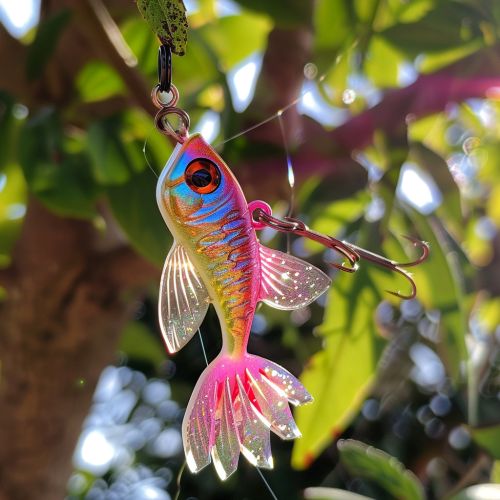Fishing Lure
Introduction
A fishing lure is an artificial bait used to attract fish by mimicking the appearance and movement of prey. Lures are designed to appeal to the predatory instincts of fish, triggering a strike. They are an essential tool in angling, a method of fishing that involves the use of a rod, line, and hook. This article delves into the various types of fishing lures, their history, design, and usage, providing a comprehensive understanding for both novice and expert anglers.
History
The use of fishing lures dates back to ancient civilizations. Early lures were crafted from bone, wood, and stone, often resembling small fish or insects. The development of metalworking techniques in the 19th century led to the creation of more sophisticated lures, such as the spoon lure, which mimics the movement of a wounded fish. The 20th century saw the introduction of plastic and rubber lures, expanding the variety and effectiveness of artificial baits.
Types of Fishing Lures
Fishing lures come in various shapes, sizes, and materials, each designed for specific fishing conditions and target species. The primary categories include:
Jigs


Jigs are versatile lures consisting of a lead sinker with a hook molded into it, usually covered by a soft body to attract fish. They are effective for both freshwater and saltwater fishing and can be used to catch a wide range of species, including bass, walleye, and snapper.
Spoons
Spoon lures are metal lures that wobble and flash as they move through the water, resembling a distressed baitfish. They are particularly effective for catching predatory fish such as pike and trout. The shape and weight of the spoon determine its action and depth.
Spinners
Spinners feature a blade that spins around a central axis, creating vibrations and flashes that attract fish. They are commonly used in freshwater fishing to catch species like bass, perch, and salmon. The speed of retrieval and the size of the blade can be adjusted to suit different fishing conditions.
Soft Plastics
Soft plastic lures are made from flexible materials that mimic the texture and movement of live bait. They come in various shapes, such as worms, grubs, and minnows, and are often used in conjunction with other lures like jigs. Soft plastics are popular for targeting species like largemouth bass and flounder.
Crankbaits
Crankbaits are hard-bodied lures designed to dive and swim in a lifelike manner when retrieved. They come in different shapes and sizes, each with a specific diving depth and action. Crankbaits are effective for catching a variety of species, including bass, walleye, and muskellunge.
Topwater Lures
Topwater lures are designed to float on the surface and create disturbances that attract fish. These lures include poppers, walkers, and frogs, each with a unique action that mimics prey struggling on the water's surface. Topwater lures are particularly effective for catching aggressive species like bass and northern pike.
Design and Materials
Fishing lures are crafted from a variety of materials, each offering different advantages. Common materials include:
Metal
Metal lures, such as spoons and spinners, are durable and provide excellent flash and vibration. They are often used in environments where durability is crucial, such as rocky or heavily vegetated waters.
Plastic
Plastic lures, including crankbaits and soft plastics, offer versatility in shape, color, and buoyancy. They can be molded into lifelike representations of prey and are often used in clear water where visual appeal is essential.
Wood
Wooden lures, though less common today, are prized for their buoyancy and natural action. They are often used in topwater lures and larger crankbaits.
Techniques and Strategies
The effectiveness of a fishing lure depends on the technique used to present it. Key strategies include:
Retrieval Speed
The speed at which a lure is retrieved can significantly impact its action and attractiveness to fish. Faster retrievals often trigger aggressive strikes, while slower retrieves can entice more cautious fish.
Depth Control
Controlling the depth at which a lure is fished is crucial for targeting specific species. Weighted lures and diving crankbaits can reach deeper waters, while surface lures and unweighted soft plastics are ideal for shallow fishing.
Action and Presentation
The action of a lure, such as wobbling, spinning, or darting, can be manipulated through rod movements and retrieval techniques. Matching the lure's action to the behavior of the target species increases the chances of a successful catch.
Environmental Considerations
The use of fishing lures has environmental implications. Responsible anglers should consider the following:
Lead-Free Alternatives
Lead-based lures can pose a threat to wildlife if lost in the water. Many manufacturers now offer lead-free alternatives made from materials like tungsten and bismuth.
Catch and Release
Using barbless hooks and minimizing handling time can reduce the stress on fish, increasing their chances of survival after release.
Habitat Preservation
Avoiding sensitive habitats and practicing ethical fishing techniques helps preserve aquatic ecosystems for future generations.
Innovations and Trends
The fishing lure industry continues to evolve with advancements in technology and materials. Recent trends include:
Biodegradable Lures
Biodegradable lures made from natural materials are gaining popularity as environmentally friendly alternatives to traditional plastic lures.
Electronic Lures
Electronic lures equipped with lights, sounds, and vibrations are designed to attract fish more effectively, particularly in low-visibility conditions.
Customization
Anglers can now customize lures with interchangeable parts, allowing for greater flexibility in adapting to different fishing conditions and target species.
Conclusion
Fishing lures are a vital component of modern angling, offering a wide range of options for attracting and catching fish. Understanding the different types of lures, their design, and effective techniques can enhance an angler's success on the water. As the industry continues to innovate, anglers have more tools than ever to pursue their passion responsibly and sustainably.
